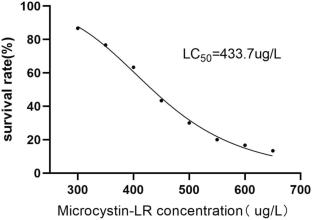Evaluation of Microplastics and Microcystin-LR Effect for Asian Clams (Corbicula fluminea) by a Metabolomics Approach
Abstract
Microplastics (MP) and microcystins (MCs) are two co-occurring pollutants in freshwater ecosystems that pose significant risks to aquatic organisms and human health. This study investigates the interactions between MP and MCs and their effects on the metabolic responses of freshwater aquaculture. Asian clams have been used as an indicator of microplastic pollution in freshwater ecosystems. The present study investigates metabolic responses of Asian clams during microplastic and microcystin-LR stress to identify health impacts and elucidate mechanistic effects of external stressors on Asian clams. A liquid chromatography/mass spectrometry (LC–MS)-based metabolomics approach was used to identify metabolic perturbations and histological section technique was used to assess changes of tissues from different Asian clam treatment groups. The results showed significantly pathological changes in the gills and hepatopancreas in experimental clam compared to control (healthy) clam. Metabolomics revealed alterations of many metabolites in the hepatopancreas of six Asian clam comparison groups, reflecting perturbations in several molecular pathways, including energy metabolism, amino acid metabolism, protein degradation/tissue damage, and oxidative stress. Overall, this study emphasizes the importance of understanding the interactions between MP and MCs and the need for proactive measures to safeguard freshwater ecosystems and human health.


 求助内容:
求助内容: 应助结果提醒方式:
应助结果提醒方式:


